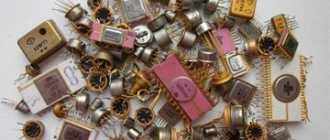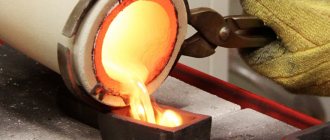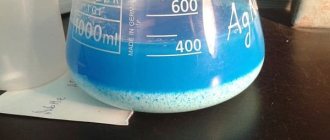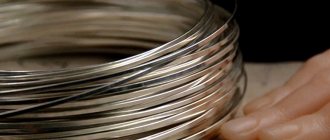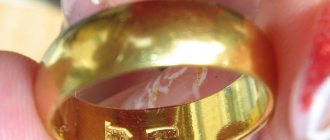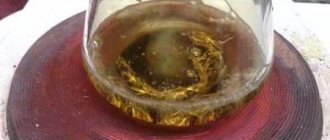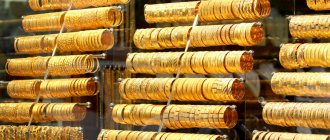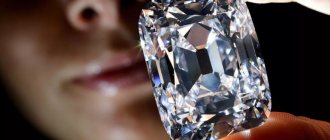In appearance, platinum is similar to silver, but in price it is much closer to gold.
And this is enough for platinum mining to develop.
The combination of the advantages of platinum, the demand for this metal and environmental requirements has led to the development of technologies for the secondary use of this metal.
platinum from waste , which is done not only by specialized companies, but also by home craftsmen.
Platinum is the most common metal of the platinum group, which also includes rhodium, palladium, iridium and others. All these metals have very similar properties, including high cost and unique qualities.
Raw materials for refining
The most common raw materials for refining are gold and silver, less commonly platinum.
Also suitable for the procedure:
- jewelry scrap;
- household and technical scrap;
- coins;
- spot and rough gold.
Refining is a procedure that is carried out in special factories. The incoming raw materials contain many impurities; upon receipt they will undergo melting in powerful furnaces. After this, the optimal refining method is selected and the process starts.
Despite its complexity, refining is a processing that can be done at home if you have certain skills and tools.
Refining tools
To carry out refining at home, it is important to have special equipment:
- Crucible. This is a container in which metal is melted and can withstand very high temperatures. Buying a crucible is not difficult; it can be found in specialized stores. To ensure that the melting process does not take much time and that difficulties do not arise at this stage, it is recommended to purchase a crucible furnace. Modern installations are implemented with a built-in crucible of various volumes. Important! The crucible must be clean and used only for processing one type of metal. For convenience, you can apply markings indicating the type of metal used.
- Tweezers. It must be large and durable. Tweezers are used to transfer zinc into the prepared gold.
- A durable knitting needle with a thickness of at least 2 mm. It can be steel or titanium. A knitting needle is needed to stir molten metal; it is sold in any jewelry store.
- Flask with a volume of at least 0.5 liters. It is intended for boiling; the glass from which it is made must be fireproof.
- Electric stove and cap. It is important that the spiral in the tile is closed. The cap is needed to cover the crucible. The design is easy to make yourself: soak the asbestos and mix it with gypsum in a 1:1 ratio.
Implementation
Platinum extracted from recycled materials can be sold through various channels :
- to a pawnshop;
- into buying;
- to a specialized recycling company.
But in practice, the sale of mined platinum is not possible in every pawnshop or purchase.
The most promising cooperation is with a specialized recycling company .
The price of platinum fluctuates depending on the market situation, which is usually assessed based on the platinum quotation rate on the London Stock Exchange.
It is this quotation that determines the prices in different platinum purchase and sale networks, and the difference in cost often becomes the subject of public discussion.
On one day, prices for this metal can be, for example, like this:
- Sberbank of Russia rate for receiving platinum is 1618.0 rubles per gram;
- rate for receiving platinum scrap in a pawnshop – 1350.0 – 1600.0 rubles per gram;
- The rate for purchasing platinum jewelry is 1300.0 – 4500.0 rubles per gram.
The initial stage of gold refining is melting
Where to begin? Refining is a procedure that requires compliance with rules at all stages. Even a slight deviation from the sequence will not lead to the desired result.
Gold refining begins with melting the metal. It is important to prepare the crucible correctly - it must be dry and hot. Calcination of a wet crucible is not allowed to avoid cracking.
Borax is poured into the crucible and leveled along its bottom. Raw materials containing gold are placed on top. The heating process begins, and as the temperature increases, the metal acquires a red tint. At this moment you need to pour borax on top and continue heating.
Zinc loosening
There are two popular ways to refining gold at home: using zinc or copper. The simplest method is to purify the precious metal with zinc; it serves as a disintegrant for gold molecules to easily remove impurities.
After a dense lump of gold appears at the bottom of the crucible, floating in the borax, you can begin to add zinc. It is placed in the crucible in small portions. Failure to comply with this rule will lead to the release of the alloy, because Gold and zinc have different melting points (they differ by more than 500 degrees). The heating temperature when adding zinc must be constantly increased.
After the zinc has completely dissolved, the alloy must be stirred with a knitting needle and the temperature reduced.
Extraction from secondary raw materials
Knowledge of the peculiarities of the processes for extracting precious metals from secondary raw materials is important not only for direct technical execution. Understanding such technologies allows us to better organize the collection of suitable raw materials and anticipate the directions of development of these processes.
Very
conventionally, work on the extraction of platinum from secondary raw materials is divided into those carried out by enterprises that manufacture products using this metal, and those carried out by recycling organizations engaged only in the processing of third-party source materials.
Enterprises working with platinum operate their own or subcontracted waste disposal systems .
Specialized organizations are engaged not only in processing, but also in purchasing raw materials from various sources :
- purchasing secondary raw materials from enterprises;
- purchasing platinum in the form of scrap;
- purchasing platinum-containing products, for example, radio components.
One of the areas of work of recycling enterprises in purchasing raw materials is interaction with the population . Those interested in participating in recycling technologies can even extract platinum from waste and products themselves. Jewelers also work with platinum.
Removing the alloy from the crucible and grinding it
To continue refining gold, the alloy must be removed from the crucible. Extraction occurs using tweezers, and the lump is immersed in water. At this stage the alloy should have a silver color.
Then the resulting ingot is crushed in a regular mortar. The process is not difficult - it is very fragile. For best results, the degree of grinding should be maximum.
Gold panning
A flask is placed above the stove, and the resulting powder is poured into it. Nitric acid is also added there in an amount of no more than 50 ml.
The reaction follows immediately - the release of multi-colored steam begins. It is advisable to perform this procedure outdoors - the steam is very caustic. After some time (when the reaction weakens), another 50-100 ml of acid is added.
After the reaction is complete, the flask must be heated slowly until clear steam appears. Heating stops and cold water is poured into the flask. The resulting solution must be shaken - the gold particles will settle to the bottom, and the water must be carefully drained, avoiding loss of gold. The procedure is repeated several times, with each subsequent washing the water becomes cleaner, its complete transparency indicates the completion of the washing stage.
If the technology is strictly followed, pure gold will remain at the bottom of the flask, without foreign impurities and zinc.
The final stage is receiving a gold bar
In order for the precipitate of gold particles to form into a more familiar gold bar, it must be melted and bleached.
To do this, the gold flakes are filtered using gauze, and they are sprinkled with borax in it. Then the gauze is dried and placed in a crucible, covered with a cap. The crucible is placed on the tile and the heating process begins. As a result, a lump of gold is formed, and the gauze smolders. To clean gold more deeply, you can sprinkle it with borax again.
After the gold has completely solidified, the lump is removed from the crucible and boiled in bleach (a solution of hydrochloric, nitric acids and water) for no more than 5 minutes. Next, it is washed in running water.
The result is a gold bar of the highest standard.
Refining gold using copper is identical to the refining process using zinc. The difference is that copper is initially melted, and gold is added to it in small portions. During the refining process, additional equipment will be required - rollers. They are designed for rolling the finished alloy of copper and gold into thin strips, which should be cut as finely as possible. These small particles are then placed in a flask and go through the same steps: heating, washing, re-melting and forming the finished ingot.
Platinum
Platinum, chemical sign Pt, atomic weight 193.4, melting point 1746° (Nernst), specific gravity 21.48. In nature it is found in native form, but never in pure form, but usually with an admixture of palladium, iridium, ruthenium, rhodium and osmium; the latter metals are constant satellites of platinum and are therefore called platinum group metals; in addition, often with an admixture of copper and iron. The main deposit of platinum is the Urals; found in small quantities in California, Brazil, Borneo, Domingo and Australia.
Metallic platinum has a white color, somewhat with a bluish tint, a completely metallic luster and, when welded, is distinguished by greater hardness than alloyed platinum. When heated, it is forged, welded and drawn into thin wire. Minor impurities of other metals greatly reduce malleability; therefore, commercial platinum, usually containing iridium, is much more fragile than pure platinum. Platinum belongs to the refractory metals, which is why it is used as a material for crucibles used in chemical laboratories. Platinum melts easily in a lime crucible in the flame of detonating gas and illuminating gas burned in a stream of oxygen (on a Deville lamp). In white heat, two platinum pieces are welded; in red-hot - platinum vessels pass hydrogen through the walls; other gases do not diffuse. Does not change in air, does not oxidize even in extreme heat; acids: hydrochloric, nitric, sulfuric and hydrofluoric have very little effect on it. In view of this, platinum vessels are used in factories for evaporating chamber sulfuric acid to a strength of 66° B. Only aqua regia easily and completely dissolves platinum. Hydrates of potassium, sodium, lithium oxides, as well as lithium chloride, have a strong effect on platinum, as does a mixture of nitrate and potassium oxide. A mixture of coal and silica acts on platinum, forming brittle siliceous platinum; In view of this, it is not recommended to heat platinum crucibles between coals. Spongy platinum is obtained by calcination of ammonium chloroplatinate (NH4)2 PtCL6 - it is a gray spongy mass, which, at white heat and under strong pressure, is welded into a compact mass and takes on the metallic luster of polished steel. Platinum black, a black, coal-like, heavy powder that under pressure takes on a white color and a metallic luster, is nothing more than metallic platinum in a state of very fine grinding. Platinum black is obtained by reducing platinum compounds (wine alcohol, sugar, formaldehyde) in an alkaline environment. Platinum black and sponge platinum have the ability to absorb gases, especially oxygen; a volume of platinum black can condense several hundred volumes of oxygen in its pores. The property of finely crushed platinum to concentrate oxygen in its pores and give easily reducible lower oxidation states on the surface of its crushed small particles determines the oxidative effect of platinum in these states even at ordinary temperatures. The oxidizing agent is oxygen, air. Due to the ability of platinum black to accelerate oxidation, in technology platinum in the form of black is used for the oxidation of sulfur dioxide into sulfuric anhydride, wine alcohol into acetic acid, etc. For the oxidation of sulfur dioxide into sulfuric anhydride, the best temperature is 400 °, since at this temperature, the highest yields of SO3 are obtained. This action (accelerating and increasing the oxidation) of platinum is called contact, or catalytic (see catalysis). Platinum is used for chemical and electrochemical purposes, as well as as a material for chemical vessels (crucibles, cups, wire, tin), for the manufacture of retorts for evaporating sulfuric acid; platinum salts are used not only in chemical analysis, but also in technology, for example, for photography; in the form of platinum black - in chemical oxidation reactions. Due to the rarity of the metal and its technical applications, the price of platinum has increased greatly in recent years. For information about platinum deposits and mining, see the appendix.
E. Orlov.
Extraction of platinum and its compounds.
Native platinum, found in nature in placers, is never pure, representing an alloy of platinum with iridium, palladium, rhodium, iron, copper and sometimes osmium. Platinum placers occurred through the destruction of a large mass of rocks, in which the platinum content is much lower than in placers. The companions of grains and leaves of native platinum in placers are grains of quartz, serpentine, zircon, corundum, titanium and chromium iron ore, gold, etc. Platinum-containing sand is no different in appearance from ordinary sand. Curl considers the average platinum content in this sand to be 6-8 g per 1000 kg, sometimes it rises to 40 g or drops to 2.6 g. The production of platinum from placers is divided into two parts: the isolation of native platinum from socks and its purification. Native platinum is extracted from sands, like gold, by washing; and sometimes it is also treated with mercury to extract gold. The washing product is marketed as crude platinum, or platinum ore. For information on world platinum production and its mining in Russia, see XV, 496, Appendix Mining Statistics.
Raw platinum is purified either in special platinum plants or in chemical plants. According to Louis's description, this is how platinum ore is now processed in Russia. Heat with aqua regia in a sand bath in cups 0.6 m in diameter. The solution is evaporated to dryness, the residue is extracted with hydrochloric acid, the solution is evaporated again and the residue is treated with hydrochloric acid, repeating this until the nitric acid is completely decomposed. The latter solution is filtered from the sediment, which is sold to German chemical plants that process it into platinum group metals. The solution is precipitated with ammonia (NH4Cl); The ammonia sediment is washed on special filters with a pump and is obtained in the form of tiles. It is dried slowly and calcined in a muffle on platinum plates. The result is a tile of spongy platinum. It is crushed and pressed in an Abich steel mortar, and then smelted in the Deville furnace. The fused platinum is cast into molds made from limestone tuff. The resulting blanks are 5 cm thick. The ammonia mother solution, strained from chloroplatinate, also contains platinum. It is precipitated with iron and then refined like raw platinum.
Platinum forms compounds with other elements either as PtX2 oxide (for example, PtO, PtCl2) or as PtX4 oxide (for example, PtO2, PtCl4); here - X denotes a monovalent element, for example CI. In chemical practice, the so-called platinum chloride, obtained by dissolving platinum in aqua regia under low heat; a brown solution is obtained, from which brown-red prisms of the composition can be isolated by evaporation: H2PtCl6.6H2O. This substance is called platinum chloride. When heated, water, HCI, and part of the chlorine are removed from this compound; what remains is PtCl2, platinum chloride. The compound PtCl4 can be obtained from H2PtCl6.6H2O by heating in a stream of chlorine at 360°. PtCl4 crystallizes from aqueous solutions with 4H2O. The compound H2PtCl6 is taken to be a special kind of acid called hydrochloroplatinic acid. Because there are numerous salt-like derivatives of it, in which its hydrogen is replaced by a metal or ammonium group, for example K2PtCl6, (NH4)2PtCl6; These compounds are called chloroplatinates, for example potassium, sodium. Platinum chloride, PtCl2, is insoluble in water, but quickly dissolves in hot hydrochloric acid, forming the acid H2PtCl4 in an aqueous solution; salts of this acid, for example, K2PtCl4, (NH4)2 PtCl4, are called chloroplatinites (for example, potassium, sodium). Chloroplatinates and chloroplatinites are called complex salts. Complex salts are generally characterized by the fact that during exchange reactions the role of one of the ions is played by a complex complex of atoms grouped around the metal atom, as if near the central nucleus, for example: 1) K2PtCl6 + 2AgNO3 = Ag2PtCl6 + 2KCI; 2) K2PtCl4 + 2AgNO3 = Ag2PtCl4 + 2KCl. Here, a complex of atoms grouped around the platinum atom, as if near the central nucleus, (PtCl6), (PtCl4), plays the role of a negative ion of a simple salt, for example CI in potassium chloride, KCI.
In addition to the above-mentioned salts, platinum forms numerous complex compounds in which platinum-ammonium complexes play the role of ions, for example Pt(NH3)4X2 or Pt(NH3)6X4, where X=CI, Br, J, (NO3), ½ (SO4) . In these salts, the role of the metal is played by a di- or tetravalent complex consisting of a platinum atom and 4 or 6 particles of ammonia. As can be seen, the valence of platinum itself in relation to X remains the same after the addition of ammonia as in its simple compounds: Pt(NH3)4Х2 compounds are called platosamine salts and are obtained from platinum oxide salts, Pt(NH3)6Х4 compounds are called platinum amine salts. But for both series there are salts with a lower ammonia content, generally with (NH3)n, where n = 6, 4, 3, 2 and 1. The loss of ammonia is reflected in the change in the properties of X-s: when one ammonia disappears, it also disappears at the same time one X, as an ion with its mobility, and X enters the very complex near the platinums instead of the departed NH3; For example:
[Pt(NH3)6]Сl4; [Pt(NH3)8/Cl2]Cl; [Pt(NH3)2/Cl4] and [Pt(NH3)8/Cl5]K. Studying the electrical conductivity of solutions of these platinum compounds was a simple and quick means for Werner to decide how many Xs in a given salt had a specified ion mobility. Studying complex compounds of platinum, cobalt, chromium, etc., Werner noted two characteristic features of them: 1) the number of molecules of water, ammonia, etc., joining the molecule of the metal salt in hydrates, ammonia, the number of negative atoms or residues included in the composition of complex salts has a strictly defined meaning, 6 is repeated most often, then 4; 2) acidic residues that are part of complex molecules: Cl, J, NO2, NO3, SO4, etc. can have a significantly different character. In some cases, these residues have the character of typical ions, they are characterized by mobility and a tendency to undergo salt exchange reactions, for example [Pt.4NH3).Cl2; [Pt.4NH3)(NO3)2, etc. In other cases, on the contrary, the acidic residues are firmly held by the complex molecule and do not enter into exchange decomposition instantly, like salt anions, but relatively slowly; in general, they rather resemble atoms or residues associated with carbon in organic compounds, for example, in C2H5Cl; CH3CI. There are also mixed types, where in the same complex molecule, along with easily mobile and, therefore, ionized acidic residues, there are low-mobile and tightly bound ones, for example, in [Pt(NH3)8/Cl3]Cl. To explain various cases of complex compounds, Werner proposed a coordination theory, according to which in each complex molecule one atom (most often a metal, for example, Pt, Co, Cr, Cu) occupies a central position (nucleus), and all other atoms are grouped around it , atomic groups and whole molecules. This will be the central atom of the molecule. The number of atoms or groups immediately adjacent to the central atom and that can fit in the so-called internal, or first coordination sphere, according to Werner, is strictly limited, and, moreover, does not depend on the method by which they are connected with other parts of the molecules. In the vast majority of cases it does not exceed 6; in some cases it is less than 6, for example, 4. When the number is 6, then the atoms or atomic groups immediately surrounding the central atom are located at the corners of some octahedron, in the simplest case a regular one; when the number is 4, atoms or atomic groups are located at the four corners of a quadrilateral or square (Fig. 1 and 2).
Werner associates the distribution of the constituent parts of a complex molecule with the second feature of complex compounds, to which attention was drawn above. The components of the first, or inner, sphere are bound directly to the central atom and, moreover, firmly, similar to how chlorine is bound to carbon in organic compounds. On the contrary, the components of the outer sphere are connected to the central atom through other atoms or groups, are easily mobile and are prone to ionization. For clarification, we will analyze several cases from the group of platosamine compounds. For example, when NH3 acts on platinum dichloride, PtCl2, depending on the conditions, several different compounds are formed; Of these, we will focus here on only four. One of them contains 4 NH3 molecules, for example, PtCl2.4NH3, the other three correspond to the same empirical formula PtCl2.2NH3. Compound PtCl2.4NH3, so-called. chloride of the 1st base Reise, easily reacts with lapis, and both chlorine atoms replace the nitric acid residue: PtCl2.4NH3 + 2AgNO3 = Pt(NO3)3 4NH3 + 2AgCl; and also with wet silver oxide it gives 2АgСІ and Pt(OH)2. 4NH3, representing a strong alkali. From here it is clear that in this Reize salt both chlorine atoms are in the nature of ions (anions) and that the Pt.4NH3 group is a divalent cation Pt4NH3, and therefore the coordination formula of the chloride of the first Reize base will be Cl2; hydrate: [Pt. 4NH3](OH)2, nitrate salt [Pt. 4NH3](NO3)2, etc. Of the three other mentioned compounds with the general empirical formula РtCl2.2NH3, two, quite similar to each other (slightly soluble yellow bodies), react difficultly and slowly with lapis and are generally not very prone to reactions exchange decomposition. Obviously, the chlorine atoms in them are not ionized (or are difficult to transform into the ion state), and therefore, according to Werner, they should be assigned the coordination structure [Pt.2 NH3Cl2); in other words: all the constituent parts of the molecule are placed here in the inner sphere, in direct connection with the platinum atom. However, these substances differ in many respects (crystalline form, solubility, reactions) and are obtained in different ways. One of them, called the chloride of the 2nd Reize base, is formed by the elimination of 2 NH3 molecules from Cl2 chloride when the latter is heated or when it is exposed to hydrochloric acid. Another, called Peyron's salt, is obtained by the action of NH3 (in a relatively small amount) on a solution of PtCl2 in hydrochloric acid, or on the double salt PtCl2. 2 KSI. Both of these bases, when exposed to NH3, give the chloride of the 1st base Reize [Pt. 4NH3]Cl2. All this indicates that they have the same molecular weight and, therefore, are isomeric. Their difference is due to the different spatial arrangement of the 2 NH3 and Cl2 atoms in the molecule; but this will be mentioned later. The third (last) compound of the empirical formula is PtCl2. 2NH3, characterized by very difficult solubility in water and green color, is called Magnus salt. Judging by the empirical formula, it is isomeric with the two previous ones, but, unlike them, it has a formula that is twice as complex. It is known that KCI, NaCl, NH4Cl easily combine with platinum dichloride, PtCl2, giving compounds of the PtCl2 type. 2MeCl or PtCl2.MeCl2, etc. (Me=Na, Ka, NH4, Mg). The resulting simple compounds are salts of some dibasic complex acid of the formula H2 [PtCl4]: in this acid, platinum is part of the anion, and hydrogen plays the role of a cation. The above-mentioned double compounds should be considered as salts of such a complex acid K2, Na2, Mg. When lapis acts on these double salts (chloroplatinites), a silver salt of the same complex acid is formed in the form of an insoluble precipitate of salmon-red color: K2 (Pt Cl4) + 2Ag NO3 = Ag2 (Pt Cl4) + 2 KNO3. All chloroplatinites give this characteristic reaction, and therefore it can serve to recognize H2 salts (PtCl4). Now, if we act on the above-mentioned salt of Magnus with lapis, then the green color instantly turns into salmon-red, and the study of the transformation products shows that the latter is expressed as follows [PtCl2. 2 NH3]2 + 2 Ag NO3 = Ag2[PtCl4] + [Pt. 4NH3].NO2. It is clear, therefore, that the Magnus salt is the product of a combination of two complex ions: [PtCl4] (negative) and , (positive) that it is chloroplatinite of the 1st base of Reize: [Pt. 4NH3]PtCl4. The correctness of this conclusion is confirmed by its synthesis: if you merge a colorless solution of the salt of the 1st base of Reize with a red solution of some chloroplatinite, you will immediately obtain an abundant precipitate of the green salt of Magnus:
Cl2 + K2 [PtCl4] = [Рt4NH3][РtCl4] + 2KСІ.
Rice. 1.
Rice. 2.
Rice. 3.
What explains the difference between the two isomeric salts: Peyrone's salt and the chloride of the 2nd Rhine base. Peyrone's salt is obtained by the action of NH3 on H2PtCl4 salts:
(NH4)2 + 2NH3 = [Pt.2 NH3Cl2] + 2NH4Cl.
This is an orange-yellow crystalline powder; 1 part by weight dissolves in 26 parts by weight of water at 100° and 387 parts by weight at 0°. The chloride of the 2nd Reise base is obtained by the elimination of NH3 from the salt of the 1st Reize base:
(Pt4NH3)Cl2 = (Pt2NH3Cl2) +2 NH3. Microscopic octahedra are pale yellow. 1 part by weight dissolves in 160 parts by weight of water at 100° and 4472 parts by weight at 0°. When exposed to pyridine, both substances give different, but isomeric compounds that correspond to the general coordination formula (Pt2NH32Py).Cl2. (Here the symbol Py stands for pyridine.) Werner explains the isomerism of Peyronnet and Reize salts based on a planar diagram, which, in his opinion, should correspond to the coordination number 4. It is easy to see that here, according to theory, two and only two spatial isomers are possible, as can be seen from the following diagrams in Fig. 3. By converting Peyronnet and Reize salts into pyridine compounds, synthesizing the same pyridine compounds from pyridine salts similar to the above-mentioned Peyronnet and Reise salts, and studying their relationship to high temperature and the action of HCI, Werner was able to prove the validity of the planar representation of both isomeric compounds.
Salts of different compositions are obtained from platinum-amine compounds, for example:
[Pt(NH3)6]Cl4; (Pt(NH3)6] (NO3)4; [Pt(NH3)6] CO2; [Pt(NH3)6](SO4)2; [Pt(NH3)4/Cl2](NO3)2, etc. It is interesting that the [Pt(NH3)6] complex has some similarities with alkaline earth metals, since its carbonic acid and sulphate salts are characterized by low solubility in water. By the action of nitric acid on Magnus's salt, Gro obtained a white powder, the so-called chloroplatinideiamine nitrate , composition: [Pt(NH3)4/Cl2](NO3)2 This is Gro’s nitrate salt.
The salts obtained: [Pt(NH3)4/NO3](NO3)2 and [Pt(NH3)8/ (OH)2](NO3)2 are called Gerard salts. Kleve salt: [Pt(NH3)8/ Cl3]Cl – chloroplatinum monodiamine chloride, etc., etc.
See L. A. Chugaev, “On the chemical structure of complex compounds” (St. Petersburg, 1910).
E. Orlov.
Safety rules for refining
Refining of precious metals carried out at home must be carried out in compliance with safety rules:
- The room in which the refining takes place must be spacious, not cluttered with foreign objects. This is especially true for flammable items.
- It is recommended to use an exhaust design, since chemical fumes are very toxic, and open windows will cause a draft that interferes with work.
- When starting refining, you need to wear fireproof gloves and an apron. The body must be completely covered with clothing that is difficult to burn.
- Special glasses are put on the eyes, and the mouth and nose are covered with a respirator.
- Hair tends to absorb toxic substances, so it is also advisable to cover it.
The jewelry industry does not stand still, and today it is possible to obtain precious metals of the highest standard, without the content of foreign impurities. It is important to understand that gold obtained by refining at home is prohibited for sale. In most cases, amateurs simply experiment with raw materials, or refining gold and platinum, as well as other metals, illegally. The manufacture of jewelry from homemade gold is punishable by law; refining is carried out only at special purification plants or jewelry factories.
What is the value of the metal?
A beautiful and noble metal, platinum is used in jewelry and for minting coins. This is a banking and exchange metal, the bullion of which allows you to store and operate capital. Platinum is used much more widely in technology .
Application in technology is based on some
unique properties of platinum:
- the high inertness of this metal, immunity to the effects of many aggressive substances;
- excellent electrical conductivity and ability to conduct heat;
- the ability to act as a catalyst that initiates many important chemical processes.
Knowledge of the scope of platinum is also important in recycling. For this recycling strategy to be effective, it is good to properly plan and organize its collection and sorting . It is important to properly coordinate the extraction of platinum from secondary raw materials, because along with it, the part often contains other precious metals that also need to be extracted.
Here are several groups of products, materials and substances in which platinum is used. Such substances and products are an important source of returning platinum to economic circulation:
- automobile catalysts;
- radio components;
- elements of electrical equipment;
- parts made of pure platinum in devices and equipment - mesh, wire, etc.
The recovery of metals from recycled materials is more effective the larger volumes of such material are processed.
To extract platinum from each type of raw material, its own technologies have been developed .
